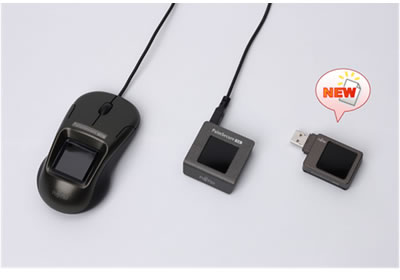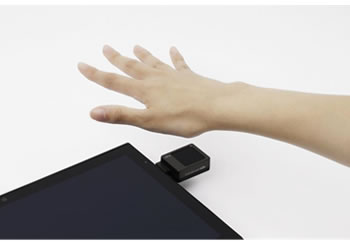Tokyo, June 16, 2015
Fujitsu Limited and Fujitsu Frontech Limited today announced the introduction of a portable sensor capable of directly connecting to USB ports. The new sensor, to be added to the FUJITSU Biometric Authentication PalmSecure-SL Sensor line of contactless palm vein authentication devices for enterprises, will be available for sale only in Japan, from late September.
The new sensor's ability to directly connect to USB ports eliminates the need for bothersome USB cables with mobile applications, and also makes it more convenient to use with tablets when out of the office or in the field.
Background
Work styles are becoming increasingly diverse as a result of the spread of smart devices in recent years. At the same time, however, the use of smart devices for work has brought its own set of issues. For example, it is easy for bystanders to peep at tablet screens, resulting in the risk of passwords getting stolen while logging in. As a result, there have been increasing needs for smart device security measures that enable easy operation even when users are standing or are at locations without desks.
To meet these needs, Fujitsu and Fujitsu Frontech will offer a portable sensor that plugs directly into USB ports, adding it to the existing line of PalmSecure-SL Sensor compact PC login sensors. This brings both convenience and security to the new work styles that smart devices make possible.
 Figure 1: Fujitsu's lineup of contactless palm vein authentication sensors
Figure 1: Fujitsu's lineup of contactless palm vein authentication sensors
Larger View (42 KB)
 Figure 2: Models in the PalmSecure-SL Sensor line.
Figure 2: Models in the PalmSecure-SL Sensor line.
From left to right: Mouse with built-in sensor, standard sensor, portable sensor.
Features of PalmSecure-SL, a Portable Sensor
The new product uses the same sensor as the existing line of PalmSecure-SL Sensors announced in August 2012 that are designed specifically for logging in to PCs, but it connects directly to the terminal without a cable, thereby increasing convenience when used with tablets or other smart devices.
1. Capable of connecting directly to USB ports, an ideal mobile device vein authentication sensor
Measuring just 62 (W) × 33 (D) × 15.5 (H) mm, the new product can easily be carried in a hand, and as it connects directly to USB ports, it is an ideal vein authentication sensor for practical use in mobile settings. It can easily be deployed for devices already in use, letting users log in conveniently and securely with a wave of the hand.
 Figure 3: The sensor being used with a tablet
Figure 3: The sensor being used with a tablet
2. Addition to the PalmSecure-SL Sensor line
Easy authentication
The new sensor has built-in functions that rapidly and continuously capture images of the user's palm, instantly selecting the best image for authentication purposes. It then automatically cross checks that data against the registered data. This eliminates the need for a brace to hold the hand steady, and users can instead simply wave their hand over the sensor to accurately authenticate themselves.
Can be used in tandem with existing line of PalmSecure-SL sensors
For users already using the mouse-type sensor or standard sensor of the PalmSecure-SL Sensor line, the new product can be added for use in mobile settings. Users can authenticate with the standard sensor when at their office, and connect the portable sensor to their smart device when on the go.
Sales Target
JPY 12 billion over the next three years for the whole Fujitsu Group (including hardware, software, and systems integration).
Features of Contactless Palm Vein Authentication
1. Internal biometric data is difficult to forge
Compared to fingerprints, which are information sources located on the body's surface, palm vein data is contained inside the body, making it more difficult to forge.
The palm also contains more blood vessels, with greater complexity, than a finger or the back of a hand, and because the veins are larger than the capillary vessels of the finger, stable authentication is possible. Authentication trials within the Fujitsu Group demonstrated high authentication accuracy(1), with a false acceptance rate of less than 0.00008% and a false rejection rate of only 0.01%, thereby delivering highly reliable security.
2. Almost all people are able to register
Fingerprint authentication can be hindered by surface abrasions on the skin or dry skin, and facial identification can be hindered by masks and other external factors, thereby preventing successful registration or cross checking of the registered image. In contrast, Fujitsu's contactless palm vein authentication device uses internal biometric data from veins inside the palm, meaning such external factors have almost no impact.
3. Contactless authentication device
The sensor is hygienic because the user does not touch a palm brace, but makes a natural motion for scanning. This, in turn, helps to minimize possible psychological resistance to its use.
4. High reliability backed by global track record
Since Fujitsu and Fujitsu Frontech released the contactless palm vein authentication device in 2004, a total of 470,000 devices have been shipped to about 60 countries around the world, and they have been used by over 63 million people(2). Even now, deployments continue to expand.
For More Information


